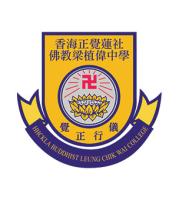| Language Policy |
Mainly adopt Chinese as the medium of instruction from S.1 to S.3 while teaching in English is partially introduced in Mathematics, Science, and Geography by modules in school-based curriculum as well as extended learning activities. In S.4 to S.6, some subjects are taught in English. |
| Learning and Teaching Strategies |
1. To create a good learning atmosphere, the following measures are implemented:<br> - Set up after-school Progressive Assessment Program in S1 and S2 to follow up closely on students’ performance. Establish “Diligence Awards” to reward students with excellent monthly assessment scores.<br> - Set up goal-setting and performance review activities at the beginning and middle of the term, and teach students effective review techniques, allowing them to continue to improve their learning.<br> - Make good use of regular classes and 2 mock examinations for S.6 students to better prepare them for the DSE.<br> - Regularly communicate with parents about the performance of the students. Making use of students' performance data to encourage them to work harder. <br>2. To improve students’ self-study and reflection abilities in the following aspects:<br> - Systematic pre-lesson materials are designed for students to help them master the key learning points and enhance their participation in class.<br> - Teach students the skill of jotting notes and integrating them into the learning and teaching process.<br> - Promote professional exchanges and mutual learning through peer observation and evaluation.<br> - Enhance students’ ability to extend their learning and research by promoting school-wide interdisciplinary and cross-subject learning.<br> - An array of precisely defined enhancement and remedial classes to enhance students’ confidence in learning and motivate them to pursue continuous improvement. |
| School-based curriculum |
1. Electives: 3X. Music, Physical Education, Japanese and Applied Learning (Hospitality Service in Practice/Everyday Japanese and Japanese Culture/Exercise and Fitness Coaching) are on offer.<br> 2. Curriculum highlights: <br>(1) Coordinate with the Education Bureau and universities to implement school-based curricula in junior forms aiming at catering for learner diversity and building a solid foundation for senior secondary education; <br>(2) Develop students' diversified talents with ample opportunities and choices, catering for individual learning needs; <br>(3) Streamline students' learning from different Key Learning Areas, with enhanced interdisciplinary collaboration; <br>(4) Cater for diverse learning needs with an array of precisely defined enhancement and remedial classes. |
| Approach to Catering for Learner Diversity |
1. Provide lunch or after-school homework tutoring programs for students with special learning needs in junior secondary schools to build a stronger knowledge base.<br>2. Regularly review the homework design to more effectively cater for students’ learning diversity and enhance students’ motivation to complete homework and pursue excellence.<br>3. Adopt split classes to improve students’ learning effectiveness.<br>4. Nurture students to become excellent students via the "Leadership Training Program" and participate in different leadership training events; <br>5. Implement Dual Class Teachers Scheme in junior forms to provide better care for students; <br>6. The Mentor Scheme aims to guide S.1 students to adapt to school life; <br>7. Subsidy is provided for students to participate in exchange programmes and study tours. |
| Approach to Integrated Education |
1. SENCO and Student Support Team offer support to students, including curriculum and assessment adaptation, learning strategies and student development;<br>2. Three social workers organize activities to help students realize their potential and enhance social skills;<br>3. The educational psychologist, speech therapist and experts give professional advice and support to students and their parents. |
| Education Support for Non-Chinese Speaking (NCS) Students |
|
| Home-School Co-operation |
The Parent-Teacher Association facilitates cooperation between parents and the school. Outstanding Students Awards are established to motivate students to strive for academic excellence. School Uniform Recycling Scheme, textbooks recycling, seminar for Parents of S.1 students, Parents' Night, interest groups, outings and seminars are organised. |
| School Ethos |
The school aspires to create an ideal learning environment for our students. Our balanced approach to discipline and care has enabled students to study in a caring and supportive environment which facilitates their healthy growth. The effort of our school has been widely recognised by parents, students and the community. In general, our students are well-mannered, eager to learn, sociable and well-disciplined. They enjoy school life, love the school and feel proud to be a BLCWC student. |
| School Development Plan |
1. Promote positive value, and unleash students' potential;<br>2. Sustained inculcation of students' self-directed learning competencies. |
| Teacher Professional Training and Development |
The Staff Development Team has devised programmes to facilitate sharing among teachers and promote educational research. Collaboration with the Education Bureau and universities enhances our professional development. The culture of peer observation, collaborative lesson preparation, coursework evaluation and teaching evaluation has firmly taken root to enhance learning and teaching quality. |
| Life-wide Learning |
1. Life-wide learning for the five essential learning experiences including intellectual development, physical and aesthetic development, value education, community service and career-related experience;<br>2. Inter-disciplinary learning programmes including project learning day, training, visits, field trips, competitions, camps and study tours;<br>3. More than 40 clubs and school teams to develop and stretch students’ all-rounded potentials;<br>4. Focus on the Student Leadership Development Program, to enhance students' sense of responsibility and belonging.<br> |
